层叠布局(Stack)
目录
1、概述
????????层叠布局(StackLayout)用于在屏幕上预留一块区域来显示组件中的元素,提供元素可以重叠的布局。层叠布局通过Stack容器组件实现位置的固定定位与层叠,容器中的子元素(子组件)依次入栈,后一个子元素覆盖前一个子元素,子元素可以叠加,也可以设置位置。
????????层叠布局具有较强的页面层叠、位置定位能力,其使用场景有广告、卡片层叠效果等。
????????如图1,Stack作为容器,容器内的子元素(子组件)的顺序为Item1->Item2->Item3。
图1?层叠布局
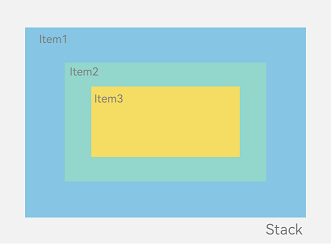
2、开发布局
????????Stack组件为容器组件,容器内可包含各种子组件。其中子组件默认进行居中堆叠。子元素被约束在Stack下,进行自己的样式定义以及排列。
Column(){
Stack({ }) {
Column(){}.width('90%').height('100%').backgroundColor('#ff58b87c')
Text('text').width('60%').height('60%').backgroundColor('#ffc3f6aa')
Button('button').width('30%').height('30%').backgroundColor('#ff8ff3eb').fontColor('#000')
}.width('100%').height(150).margin({ top: 50 })
}
3、对齐方式
????????Stack组件通过alignContent参数实现位置的相对移动。如图2所示,支持九种对齐方式。
图2?Stack容器内元素的对齐方式

3.1、TopStart?
? ? ? ? 顶部向左对齐。
@Entry
@Component
struct StackAlignContentPage {
@State message: string = 'Hello World'
build() {
Stack({ alignContent: Alignment.TopStart }) {
Column() {
}.width(200).height(200).backgroundColor(0x86C5E3)
Column() {
}.width(150).height(150).backgroundColor(0x92D6CC)
Column() {
}.width(100).height(100).backgroundColor(0xF5DC62)
}.margin({ top: 100 })
.width(350)
.height(350)
.backgroundColor(0xe0e0e0)
}
}?

3.2、Top
? ? ? ? 顶部居中对齐。
@Entry
@Component
struct StackAlignContentPage {
@State message: string = 'Hello World'
build() {
Stack({ alignContent: Alignment.Top }) {
Column() {
}.width(200).height(200).backgroundColor(0x86C5E3)
Column() {
}.width(150).height(150).backgroundColor(0x92D6CC)
Column() {
}.width(100).height(100).backgroundColor(0xF5DC62)
}.margin({ top: 100 })
.width(350)
.height(350)
.backgroundColor(0xe0e0e0)
}
}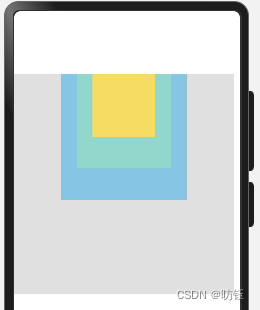
?
3.3、TopEnd
? ? ? ? 顶部向右对齐。
@Entry
@Component
struct StackAlignContentPage {
@State message: string = 'Hello World'
build() {
Stack({ alignContent: Alignment.TopEnd }) {
Column() {
}.width(200).height(200).backgroundColor(0x86C5E3)
Column() {
}.width(150).height(150).backgroundColor(0x92D6CC)
Column() {
}.width(100).height(100).backgroundColor(0xF5DC62)
}.margin({ top: 100 })
.width(350)
.height(350)
.backgroundColor(0xe0e0e0)
}
}
3.4、Start
? ? ? ? 竖直居中、横向居左对齐。
@Entry
@Component
struct StackAlignContentPage {
@State message: string = 'Hello World'
build() {
Stack({ alignContent: Alignment.Start }) {
Column() {
}.width(200).height(200).backgroundColor(0x86C5E3)
Column() {
}.width(150).height(150).backgroundColor(0x92D6CC)
Column() {
}.width(100).height(100).backgroundColor(0xF5DC62)
}.margin({ top: 100 })
.width(350)
.height(350)
.backgroundColor(0xe0e0e0)
}
}
3.5、Center
? ? ? ? 竖直居中、横向居中对齐。
@Entry
@Component
struct StackAlignContentPage {
@State message: string = 'Hello World'
build() {
Stack({ alignContent: Alignment.Center }) {
Column() {
}.width(200).height(200).backgroundColor(0x86C5E3)
Column() {
}.width(150).height(150).backgroundColor(0x92D6CC)
Column() {
}.width(100).height(100).backgroundColor(0xF5DC62)
}.margin({ top: 100 })
.width(350)
.height(350)
.backgroundColor(0xe0e0e0)
}
}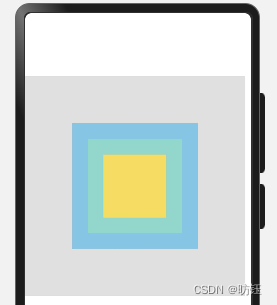
3.6、End
? ? ? ? 竖直居中、横向居右对齐。
@Entry
@Component
struct StackAlignContentPage {
@State message: string = 'Hello World'
build() {
Stack({ alignContent: Alignment.End }) {
Column() {
}.width(200).height(200).backgroundColor(0x86C5E3)
Column() {
}.width(150).height(150).backgroundColor(0x92D6CC)
Column() {
}.width(100).height(100).backgroundColor(0xF5DC62)
}.margin({ top: 100 })
.width(350)
.height(350)
.backgroundColor(0xe0e0e0)
}
}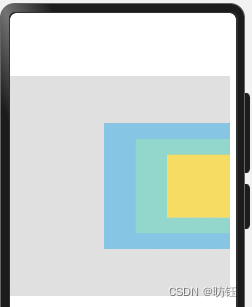
3.7、BottomStart
? ? ? ? 底部向左对齐。
@Entry
@Component
struct StackAlignContentPage {
@State message: string = 'Hello World'
build() {
Stack({ alignContent: Alignment.BottomStart }) {
Column() {
}.width(200).height(200).backgroundColor(0x86C5E3)
Column() {
}.width(150).height(150).backgroundColor(0x92D6CC)
Column() {
}.width(100).height(100).backgroundColor(0xF5DC62)
}.margin({ top: 100 })
.width(350)
.height(350)
.backgroundColor(0xe0e0e0)
}
}
3.8、Bottom
? ? ? ? 底部居中对齐。
@Entry
@Component
struct StackAlignContentPage {
@State message: string = 'Hello World'
build() {
Stack({ alignContent: Alignment.Bottom }) {
Column() {
}.width(200).height(200).backgroundColor(0x86C5E3)
Column() {
}.width(150).height(150).backgroundColor(0x92D6CC)
Column() {
}.width(100).height(100).backgroundColor(0xF5DC62)
}.margin({ top: 100 })
.width(350)
.height(350)
.backgroundColor(0xe0e0e0)
}
}
3.9、BottomEnd?
? ? ? ? 底部向右对齐。
@Entry
@Component
struct StackAlignContentPage {
@State message: string = 'Hello World'
build() {
Stack({ alignContent: Alignment.BottomEnd }) {
Column() {
}.width(200).height(200).backgroundColor(0x86C5E3)
Column() {
}.width(150).height(150).backgroundColor(0x92D6CC)
Column() {
}.width(100).height(100).backgroundColor(0xF5DC62)
}.margin({ top: 100 })
.width(350)
.height(350)
.backgroundColor(0xe0e0e0)
}
}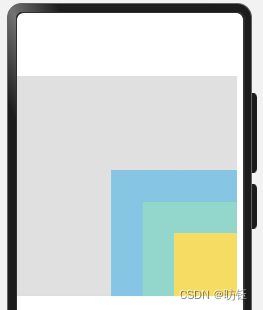
4、Z序控制
????????Stack容器中兄弟组件显示层级关系可以通过Z序控制的zIndex属性改变。zIndex值越大,显示层级越高,即zIndex值大的组件会覆盖在zIndex值小的组件上方。
????????在层叠布局中,如果后面子元素尺寸大于前面子元素尺寸,则前面子元素完全隐藏。
Stack({ alignContent: Alignment.BottomStart }) {
Column() {
Text('Stack子元素1').textAlign(TextAlign.End).fontSize(20)
}.width(100).height(100).backgroundColor(0xffd306)
Column() {
Text('Stack子元素2').fontSize(20)
}.width(150).height(150).backgroundColor(Color.Pink)
Column() {
Text('Stack子元素3').fontSize(20)
}.width(200).height(200).backgroundColor(Color.Grey)
}.margin({ top: 100 }).width(350).height(350).backgroundColor(0xe0e0e0)
????????下图中,最后的子元素3的尺寸大于前面的所有子元素,所以,前面两个元素完全隐藏。改变子元素1,子元素2的zIndex属性后,可以将元素展示出来。
Stack({ alignContent: Alignment.BottomStart }) {
Column() {
Text('Stack子元素1').fontSize(20)
}.width(100).height(100).backgroundColor(0xffd306).zIndex(2)
Column() {
Text('Stack子元素2').fontSize(20)
}.width(150).height(150).backgroundColor(Color.Pink).zIndex(1)
Column() {
Text('Stack子元素3').fontSize(20)
}.width(200).height(200).backgroundColor(Color.Grey)
}.margin({ top: 100 }).width(350).height(350).backgroundColor(0xe0e0e0)
5、场景示例
????????使用层叠布局快速搭建手机页面显示模型。
@Entry
@Component
struct StackSample {
private arr: string[] = ['APP1', 'APP2', 'APP3', 'APP4', 'APP5', 'APP6', 'APP7', 'APP8'];
build() {
Stack({ alignContent: Alignment.Bottom }) {
Flex({ wrap: FlexWrap.Wrap }) {
ForEach(this.arr, (item) => {
Text(item)
.width(100)
.height(100)
.fontSize(16)
.margin(10)
.textAlign(TextAlign.Center)
.borderRadius(10)
.backgroundColor(0xFFFFFF)
}, item => item)
}.width('100%').height('100%')
Flex({ justifyContent: FlexAlign.SpaceAround, alignItems: ItemAlign.Center }) {
Text('联系人').fontSize(16)
Text('设置').fontSize(16)
Text('短信').fontSize(16)
}
.width('50%')
.height(50)
.backgroundColor('#16302e2e')
.margin({ bottom: 15 })
.borderRadius(15)
}.width('100%').height('100%').backgroundColor('#CFD0CF')
}
}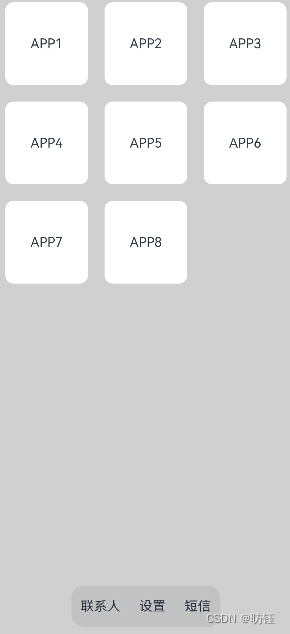
本文来自互联网用户投稿,该文观点仅代表作者本人,不代表本站立场。本站仅提供信息存储空间服务,不拥有所有权,不承担相关法律责任。 如若内容造成侵权/违法违规/事实不符,请联系我的编程经验分享网邮箱:chenni525@qq.com进行投诉反馈,一经查实,立即删除!
- Python教程
- 深入理解 MySQL 中的 HAVING 关键字和聚合函数
- Qt之QChar编码(1)
- MyBatis入门基础篇
- 用Python脚本实现FFmpeg批量转换
- JAVA——异步使用法
- 罚函数法处理不等式约束
- JS eval函数实现把字符串当脚本执行
- 【数据库设计和SQL基础语法】--用户权限管理--数据备份和恢复策略
- C++ todo
- 一篇文章带你搞定ARCHPR的下载和使用
- UGUI:一个轻量级的TFTLCD彩色显示屏GUI库
- 【PostgreSQL】数据查询-WITH查询(公共表表达式)
- vue-plugin-hiprint使用教程【2】
- 利用Spring Cloud和Java系统设置优化工程项目管理系统源码的二次开发体验